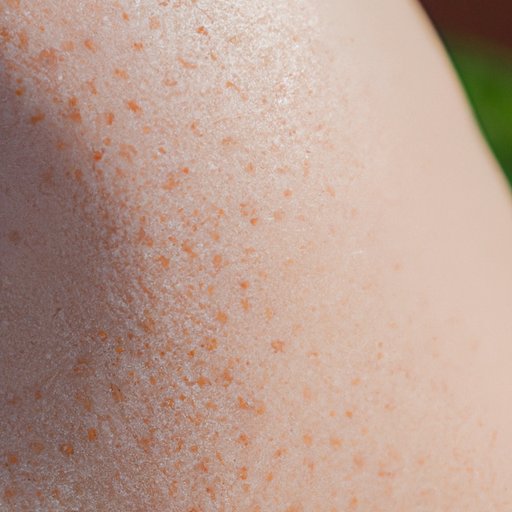Introduction
Moles are common skin growths that can appear anywhere on the skin. They range in size from a few millimeters to a few centimeters, and may be flat or raised, dark or light, single or multiple. While some moles are present at birth, most appear during childhood and adolescence, and some may develop later in life. In this article, we will explore what causes moles on skin and how they can be prevented and treated.
Investigating the Causes of Moles on Skin: A Comprehensive Guide
Moles are caused by a combination of genetic and environmental factors. Genetics play an important role in the development of moles; if a family member has moles, it is likely that other members of the family will also have them. Environmental factors such as sun exposure, hormones, and diet can also contribute to the formation of moles.
Genetics and Environmental Factors
Genetics are the most significant factor in the development of moles. If one or both parents have moles, it is more likely that their children will also have moles. Additionally, people with fair skin are more prone to developing moles than those with darker skin tones. The number of moles a person has is determined by genetic predisposition, and the number typically increases with age.
Environmental factors such as sun exposure can also contribute to the formation of moles. People who spend a lot of time outdoors are more likely to develop moles due to prolonged sun exposure. Sunburns, especially in childhood, can increase the risk of developing moles. Additionally, certain hormonal changes, such as those associated with pregnancy, can cause moles to form.
Sun Exposure
Prolonged sun exposure can lead to the development of moles on the skin. Ultraviolet (UV) radiation from the sun damages the skin, which can lead to the formation of moles. Additionally, sunburns can increase the risk of developing moles, particularly in children. To minimize the risk of developing moles, it is important to protect the skin from UV radiation by using sunscreen and wearing protective clothing when outdoors.
Hormones
Hormonal changes, such as those associated with puberty, pregnancy, and menopause, can trigger the formation of moles. During these times, hormone levels fluctuate, which can cause the skin to produce more melanin, the pigment that gives skin its color. This increased production of melanin can lead to the formation of moles.
Diet
Diet can also play a role in the development of moles. Eating a diet high in processed foods, refined carbohydrates, and saturated fats can increase the risk of developing moles. Additionally, a lack of certain vitamins and minerals, such as vitamin D and zinc, can also increase the risk of mole formation.

Debunking Myths About Moles on Skin
There are many misconceptions about the causes of moles on skin. Here, we debunk some of the most commonly held beliefs about moles.
Commonly Held Beliefs
Many people believe that moles are caused by eating too much chocolate or fried foods, wearing tight-fitting clothes, or using certain cosmetics. However, there is no scientific evidence to support these claims.
Facts Versus Fiction
It is important to recognize that while genetics, sun exposure, hormones, and diet can all contribute to the formation of moles, none of these factors alone can cause moles to form. Additionally, there is no evidence to suggest that any of the above factors can cause existing moles to become larger or darker.
Conclusion
In conclusion, moles on skin are caused by a combination of genetic and environmental factors, including sun exposure, hormones, and diet. It is important to recognize that while these factors can contribute to the formation of moles, none of them alone can cause moles to form. Additionally, there is no evidence to suggest that any of the above factors can cause existing moles to become larger or darker.
To prevent the formation of moles, it is important to protect the skin from UV radiation by using sunscreen and wearing protective clothing when outdoors. Additionally, eating a nutritious diet that is rich in vitamins and minerals can help reduce the risk of developing moles. Finally, it is important to recognize that moles can be harmless, but if a mole appears suddenly or changes in size, shape, or color, it should be evaluated by a dermatologist.


